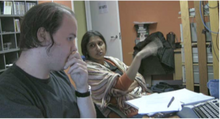Abstract[]
"The Reservations of the Editor: the routine work of showing and knowing the film in the edit suite", by Eric Laurier and Barry Brown, goes into detail about the intense collaboration between directors and editors and gives the reader an inside look into the entire process. It outlines the important role the editor plays in producing a movie and describes how the editor is expected to be the one that knows whether certain shots exist or not. Meaning that the editor has to work weeks in advance to have everything ready for his/her collaboration meetings with the director. In the edit room, collaboration is about bringing the editor’s knowledge into dialogue with the director’s vision for the documentary. The dialogue that ensues is full of interruptions and arguments. However, without the honest, involved collaboration between the editor and the director, a movie/documentary’s quality can drop severely. This article gives readers an inside look as to how editors are able to use several screens and software programs to take the director’s ideas/vision and piecing together thousands of cuts of videos to make a movie that appears seamless.
Key concepts[]
Laurier and Brown introduce the concept of collaboration in the editing suite. Both of them are expected to bring different knowledge to the table. Editors are expected to use software such as Avid, Premiere and Final Cut Pro which has, “has converted a linear process into a ‘non- linear’ process that allows editors to cut and paste video and audio just as academics cut and paste text in word-processing packages.” On the other hand, directors are expected to “know what the argument of the documentary is, what they were recording at the time, what they were trying to achieve in recording an event or person or scene, and so forth, and other surrounding facts pertinent to the documentary.” Merging their skills and knowledge together is what is necessary for them to produce a cohesive, successful film. The asymmetrical setup of the director and editor is also quite unique. While they are both collaborating, only the editor controls the screens and software programs, hence, the director’s ability to communicate his or her thoughts is vital. Laurier and Brown then take the reader through the actual progression of editing a video clip using Avid and show what the decision-making actually looks like(refer to photos in Examples section). As stated at the beginning, “During the production process a film slowly emerges as an object, like the pot of the potter’s wheel: from the three-minute pitch that begins to say what a movie might be like, to two-page treatments, to story- boards if they are made, to scripts, to shooting schedules, and so forth. What is being done is shaped by what has been done and will shape what will be done later.” The key to successful film-editing is the editor’s ability to make a scene visibly and audibly available for themselves as well as the director.
Examples[]
Editor and Director working together:

Three-monitor arrangement and documents:

Asymmetrical setup as they work through the script:

Quentin Tarantino and Sally Menke[]

One example of the editing process can be seen through a creative writing interview with Quentin Tarantino. Sally Menke has been a long time collaborator of his, and until her death in 2010, edited most, if not all of Tarantino's films. For some movies, such as Jackie Brown, he described the process as really tough and long, since he had six hours worth of footage. Sally had to help him cut it down to two and a half hours. He also described the process as making cuts in the script being similar to making cuts in the editing room. It hurts to take something out, especially if it's been with you for so long, but when it comes to editing things need to be taken out. His responsibility to take things out in the script reflects with Menke and how she has to take things out in the editing room and make these decisions with him. In the interview, Tarantino also briefly talks about how he's "not necessarily going to try to show off to the world what a great filmmaker I am." He wants to get the best performance from his actors, then edit it the right way so that their best work is showing in different parts of the movie. He also choose to have the editing really "kick in" in the third act of the movie. In the end, he's able to work out his vision on how he wants a movie laid out with Menke's help.
Critical Conversation[]
Cited a total of 11 times according to Google Scholar.. And most of the works this has been cited in is remediation in film topic.
Keywords[]
Citation[]
Laurier, Eric, and Barry Brown. "The Reservations of the Editor: The Routine Work of Showing and Knowing the Film in the Edit Suite." Social Semiotics (2011): 239-57. Web. 21 Nov. 2014.
Bauer, Erik. "Method Writing: Interview with Quentin Tarantino." Creative Screenwriting Magazine. N.p., 11 Aug. 2011. Web. 16 Dec. 2014.